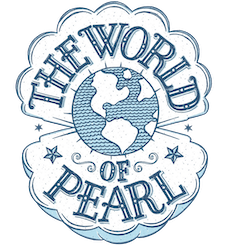What is the true color of akoya pearls? Many people have gotten caught up in the online videos of opening oysters for pearls. There has long been a trade of companies seeding akoya oysters with pearls so the oyster can be reopened to find a pearl. I just admit, I totally get it! I fly all over the world to harvest pearls and I love the thrill of going to pearl farms and opening oysters for pearls. What fun! But many of you are confused because these akoya pearls have colored pearls in them… why? That is a great question! Here is a look at a true akoya pearl harvest:


In a true akoya pearl farm, you will find a pearl in the gonad of the mollusk. This is where the nucleus is placed so the pearl will form. Here is a great photo I took in Fiji where you can see the pearl in this thick white muscle:

When akoya mollusks are reseeded with a pearl, the pearl is typically in the fleshy material of the mollusk. That is one way you know it has been reseeded! If you open a oyster and, voila, there is a pearl…. the pearl has been placed there!
But, truly, that is okay! Because only about 50% of a harvest actually yields pearls. So, if you were truly harvesting pearls, many oysters would not contain pearls! So, it is pretty lucky that you are buying oysters that pearls have been laced into, because otherwise you would have a chance of not finding any pearls at all!
And what about color? What is the true color of akoya pearls? Akoya pearls are small white pearls, they are typically between 2mm and 10mm big with the average size between 6mm-8mm in diameter. There natural color ranges from ivory or white to yellow with some gray colors. Pink overtones are very popular in these pearls. You will rarely find a black akoya pearl unless it has been colored. I know some of you have “found” chocolate akoya pearls. Unfortunately, they have been colored, too. Remember, a mollusk can only form a pearl the color of its mantle tissue. The mantle tissue is what secretes the pearl making material… the same material that a mollusk grows its shell with. No chocolate shells mean no chocolate pearls! Here are some great examples of akoya pearls from a recent harvest. This is the most common color of akoya pearls:



Akoya pearls can be colored and even high end pearl sellers will sell black akoya pearls. Here is the example I took from a reputable seller under info about their black akoya pearls:

No where in the product description do they mention their pearls have been dyed but under product information I found a D under enhancement code. This means the pearl has been dyed.
One final thing of interest. Most reseeded oysters are akoya oysters. Why? Because they are the smallest of cultured pearl mollusks so they are easy to put a pearl into, preserve and resell. This does not mean akoya pearls are always reseeded with akoya pearls! They can, and usually are, seeded with freshwater pearls. So, just because you get a pearl out of an akoya oyster does not mean you have an akoya pearls!


Happy pearl hunting!
And if you want to see the growth of the akoya oyster (which is a small oyster, check it out HERE!)
Best,
India
I am a modern day treasure hunter who travels the world for gorgeous pearls and amazing adventures. I own a pearl jewelry and jewelry repair business, ThePearlGirls.com, with a cute retail store in Athens, GA. I also have a Pearl Travel business and travel blog at TheWorldofPearl.com.


